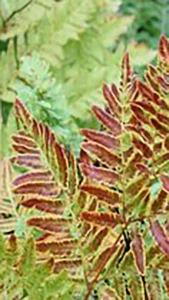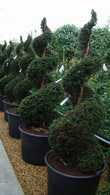Osmunda Regalis Purpurascens Royal Purple Fern
Fern for Damp Shade
1. Add items to basket
2. Go to the basket
3. Enter your postcode in Delivery Price Check
Osmunda Regalis Purpurascens or Royal Purple Fern is a tall deciduous fern with green to purple broad fronds. It suits shady damp gardens.
Osmunda Regalis is native to Europe, Asia and Africa usually growing alongside streams or in woodland bogs. It is more commonly known as the Royal Fern ‘regalis’ due to its imposing nature. The name Osmunda is derived from the Saxon name for Thor the god of lightening, sacred groves and trees.
The Purpurascens cultivar is not quite as tall as the native fern but has red-purple fronds and stems in spring. The clumped foliage matures to bright green in the summer months and as winter approaches the fronds turn yellow before dying down to ground level when the frosts arrive.
Before they unfurl the fronds are tightly packed and look similar to snail shells. The fronds can grow up to 6 feet in height if kept moist enough.
Height And Spread of Osmunda Regalis Purpurascens
Royal Purple Fern usually grows to 1.5 metres by a metre in damp UK gardens but if kept consistently moist in shade can reach several metres.
How Hardy Is Osmunda Regalis Purpurascens
This hardy fern dies down in winter to survive frosts and snow. It re-emerges in the spring.
How To Use Osmunda Regalis Purpurascens
A great choice for pond edges and bog gardens as it likes damp soils. It’s also suitable for areas that regularly flood. Royal Purple Fern will grow in cool, damp flowerbeds if the soil is consistently moist and it’s possible to grow them in containers but they will need regular water - daily in hot spells.
This is a great choice for shady cool spots in damp gardens that need height and colour. Paired with gunnera and other tall leafy plants they create a cool tropical atmosphere.
How To Care For Osmunda Regalis Purpurascens
Royal Purple Fern flourishes in damp cool soil, so pick a shady spot that doesn’t dry out. If growing in containers be sure to cover drainage holes with crocks to keep moisture around the roots.
A sheltered aspect is preferable to prevent wind damage to the tall fronds although it can withstand wind and rain.
Acidic to neutral soil gives the best results, if your soil is alkaline add lots of fibrous compost to the planting hole and mulch every year.
Cut down last year’s fronds when new foliage appears and prune out damage when necessary.












